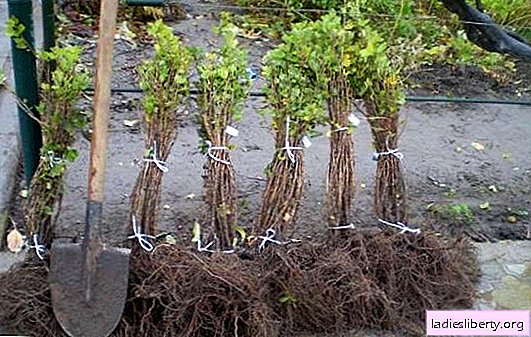
Before planting gooseberries, several issues need to be resolved: choose varieties, determine the time of planting, and select a suitable plot for growing.
In addition, you need to know what care gooseberries need after autumn planting.
Do not neglect these important little things, because the gooseberry bush is able to grow in one place for more than 20 years.
With proper care, he will delight the gardener with delicious fruits every year.
When to plant gooseberries: the timing of the procedure
It is generally accepted that planting should be carried out in the spring. But in the case of gooseberries, this must be done very early, at the very beginning of April. In some regions this is not possible, and it is difficult for a novice gardener to determine the exact date of planting shrubs. Therefore, it is best to plant gooseberries in the fall, especially if the weather is warm. In this case, the plant will have time to take root before the onset of cold weather, and in the spring it will start to grow. In addition, during autumn planting, the growth of young roots is faster.
It is very important to determine the time of landing. When is it better to plant gooseberries in the fall? The most appropriate moment is considered to be the interval from mid-October to mid-November, but these are generally accepted recommendations, in each climatic region, the dates can be shifted. For example, in the central and northern regions, planting is best carried out from mid-September until stable frosts have come. But in the southern regions of Russia can be postponed until the end of October.
Important! Gooseberry planting should be carried out three weeks before the alleged frost. It is this period that the plant needs to fully adapt.
Selection and preparation of seedlings for planting
Gooseberries are propagated by young seedlings, whose age does not exceed two years. Older seedlings take root more slowly, they need more time to adapt.
How to choose the right seedling
When buying a young seedling, you should pay attention to some indicators:
• the presence of at least three skeletal roots;
• the length of the skeletal roots should be at least 15 cm, the bark is yellow;
• the presence of a large number of fibrous roots;
• the aerial part of the plant consists of one or several shoots, the length of which is about 35-40 cm.
Preparing planting material
1. Before planting, all leaves are removed from the seedling.
2. Next, cut off all dry roots.
3. The seedling is lowered into the clay mash, which is prepared in advance. For its preparation use 1 kg of chernozem, 1 kg of clay, 2 packets of the drug "Kornevin", 3 liters of water. This solution is enough to process 20 seedlings.
Preparing the soil for planting gooseberries in the fall
Before planting a shrub, you need to choose a place and prepare the soil. Most often, gooseberries and other berry crops are grown between trees, but this is wrong. You can also not plant a plant next to currants, because they have similar diseases. It is better if potatoes, beets or legumes grew on the garden before gooseberries.
For a berry garden it is better to allocate a more illuminated place on the site. The soil should be fertile, but loose. Waterlogged and heavy lands do not fit. If groundwater passes no deeper than 1.5 meters, then it is advisable to make high beds. In addition, gooseberries are planted in a weed-free area. Such a neighborhood will not benefit the plant, therefore, before planting, the soil must be digged well.
For seedlings, they dig out pits, the size of which corresponds to the root system of the plant. Each well is filled with a mixture of fertile land with compost and fertilizer. To do this, use about 200 grams of superphosphate, 50 grams of potassium sulfate and 250-350 grams of wood ash. A mound is formed from the prepared soil mixture at the bottom of the hole and left until planting until the earth settles.
How to plant gooseberries in autumn
The procedure for planting gooseberries in autumn is no different from spring planting. But there are some features.
1. A seedling is placed in a hole and sprinkled with earth.
2. It is important to consider that the root neck during planting should be 4-5 cm below the ground level.
3. The earth around the seedling is compacted and watered abundantly.
4. After planting, mulch the soil with humus or peat.

When planting gooseberries, it is important to observe a distance between the bushes of at least 2.5 meters. Bushes can be planted both linearly and in a checkerboard pattern.
Gooseberry care in the fall: what to do after planting
After planting seedlings, the shrub needs special care. Mandatory procedures are trimming, top dressing and processing from pests.
Do I need to cut gooseberries in the fall?

In early spring, bushes need to be pruned, but is molding necessary in the fall? Immediately after planting, you need to cut off all the shoots at a level of about 5 cm from the soil surface. But adult gooseberry bushes are cut by 1/3. In general, autumn pruning of the plant is aimed at cleaning from dry and broken shoots, it is also worth getting rid of thickening and competing branches. In addition, they remove young green shoots that can not tolerate frost. But it is important to remember that in one season you can remove no more than 1/3 of all shoots. If the bush is too old, then it is rejuvenated in a few tricks.
Important! Autumn pruning of gooseberries allows the shrub to tolerate winter well.
Autumn top dressing and water-charging irrigation of gooseberries
During the autumn digging of the soil, the last top dressing of the bush is carried out. In this case, phosphorus-potassium fertilizers are used, but preparations with a nitrogen content should be postponed until spring. After the onset of stable frosts, the soil is mulched with peat or humus. The layer of mulch should be at least 10 cm. In addition, organic mulch will provide additional nutrition for the gooseberry root system.
In addition to all procedures, the last water-loading irrigation is carried out in autumn. Its purpose is to saturate the bush with moisture. But if the weather is wet, then watering is not carried out. In dry weather, the bush is abundantly watered, spending from 10 to 30 liters of water per plant. In order for moisture to flow directly to the roots, grooves up to 15 cm deep are made around the shrub.
Shrub treatment from pests
When preparing the shrub for winter, it must be sprayed with pests. Do not neglect the autumn processing, as the winter hardiness of the plant, and its yield, depend on this. Before the treatment, the soil under the gooseberries is dug up, all the fallen leaves are removed, the site is cleaned of weeds. Then sprayed with solutions from fungal infections and pests. You can use drugs containing copper, Bordeaux liquid and karbofos.
How to prepare gooseberries for the winter
Autumn gooseberry care after planting is aimed at preparing the bush for winter. If all the above steps are completed, then we can assume that the plant is already prepared. But young bushes need additional warming. When the snow falls, it is thrown under the plants and compacted. With the onset of severe frosts, you can cover the gooseberry with covering material.











